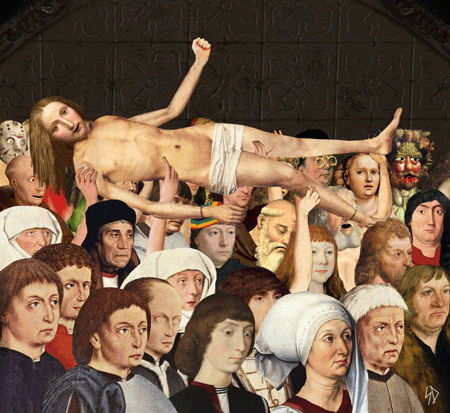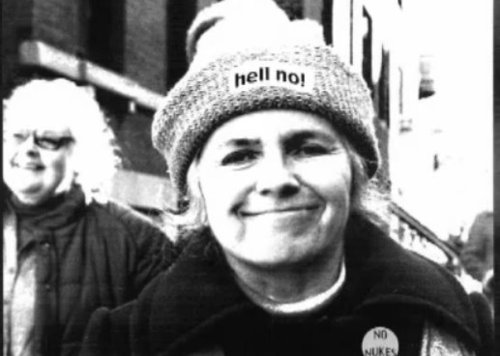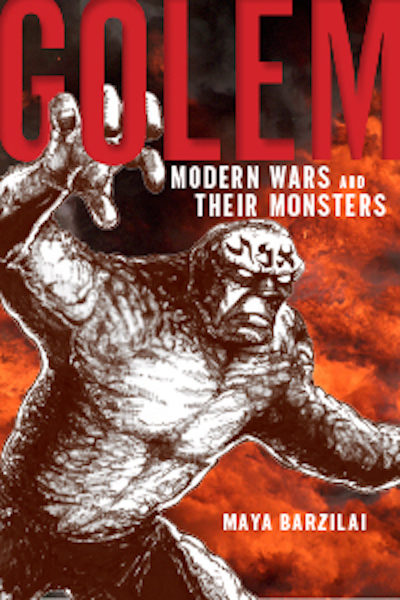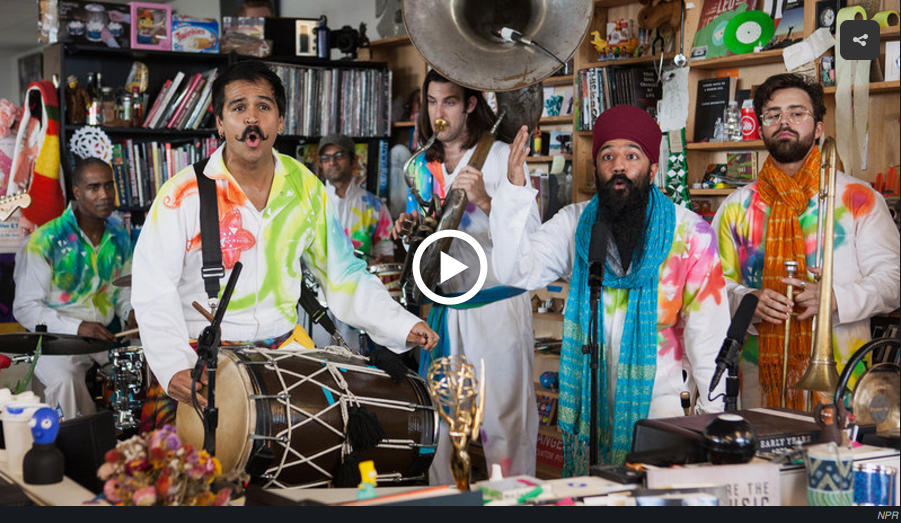In the News: Protests, Polemics, and Pastries
A round-up of recent religion news.

GIF by Scorpion Dagger
Hello, and happy Springtime.
First up in the round-up this month, some dispatches from The Resistance we hope you’ll read.
First up: “What a Forgotten 19th Century Suffragist Can Teach Us About Women’s Rights vs. The Religious Right” by S. Brent Rodriguez Plate for Religion Dispatches.
Political movements, like religious movements, rely on strange alliances. Issues are seldom singular, but meet across a range of social mores, cultural productions, religious practices, and political codes. As the United States continues under the fraught leadership of Donald Trump, we find new iterations of the “Christian nation,” new connections and clashes between immigration bans, the religious right, and women’s rights. But if oppression relies on strange alliances, so does resistance.
There’s no resister we’ve admired more than Grace Paley. We’ve been turning to her example and her words a lot lately, as has Nicholas Dames, as we discovered in “The Stubborn Optimist: Following the persevering example of the writer and activist Grace Paley” written for The Atlantic.
From her Bronx childhood to her maturity in Greenwich Village’s radical heyday, lasting to the Vermont retreat of her old age and her death in 2007, Paley was a fearless and unflagging arguer. She was someone who gained energy through the give-and-take of political debate, whose brash, blunt New York manners made the tacit sayable. A co-founder of the Greenwich Village Peace Center and a noted member of the War Resisters League whose pacifism was rooted in a continually evolving feminism, Paley blended the socialism of her secular Jewish upbringing with the unruly passions of the left during and after Vietnam: The civil-rights, antiwar, and environmental movements each counted her as an ally. Much of her arguing happened on the ground—at protests, at the constant meetings that her life as an activist demanded, during visits abroad to nations that her own country was spending its young men and money ravaging. But from the 1950s until the 2000s, much of it also happened in writing: in poetry, in essays and political reportage, and in short stories, where her brilliance found its best outlet.

We’ve also been reading the excellent work being done by Sarah Jaffe who has been publishing Interviews for Resistance in The Baffler. Each one is as revealing and informative as the next.
We are pleased to share a new, syndicated series of interviews by Sarah Jaffe. INTERVIEWS FOR RESISTANCE will introduce you to some of the key figures in the growing movement(s) against our reactionary new federal government. We hope you will find comfort in knowing the crucial work of fighting back has already begun in many (sometimes unexpected) places, and find tools in these conversations for your own part in the struggle.
And we really appreciated and felt compelled to share Ijeoma Oluo‘s pointed, funny, and pointedly funny: “Welcome To The Anti-Racism Movement — Here’s What You’ve Missed” from The Establishment
Hi! I see you there! Welcome to the anti-racism movement. I know you were kind of hoping to sneak in the back of class in the middle of this semester and then raise your hand in a few days to offer up expert opinion like you’ve always been here — but you’ve been spotted, and I have some homework for you, because you’ve missed A LOT and we don’t have the time to go over it all together. I’m glad you are here (I mean, I’d really rather you arrived sooner and I’m a little/lot resentful at how often we have to stop this class to cover all the material for people who are just now realizing that this is a class they should be taking, but better late than never I guess) and I know that once you catch up, you can contribute a lot to the work being done here.
There’s been no shortage of really excellent writing on race and religion in the last month. A few especially noteworthy examples include:
“Kameelah Rasheed: Who Will Survive in America?: The visual artist on “the stutter” in history, strategic opacity, and Black Women Artists for Black Lives Matter” a conversation between Kameelah Rasheed and
In this particular moment, many of us are scared. The question is, what are the archives directing us to do, because it’s not as if we don’t have examples. It’s not as if people have not done this work. It’s not as if people haven’t been living under a particular version of Trump’s America for a long time. I’m often reminded by elders that we’ve already been through some things. So this is not a discontinuity of our history—it is a continuation of things that are and feel familiar. I’m interested in what folks have done in the past to organize covertly to get things done. What have folks done to protect and take care of one another in moments like this? It’s very important to think about the archive as a starting place, a place to go and get lessons, but also as a place that needs to be continuously maintained and taken care of.
Also on the topic of race, religion, gender, and history, Josef Sorett wrote “Religion and Gender Trouble in the Black Arts: Remembering Toni Cade Bambara’s The Black Woman” for Religion Dispatches.
In bringing together a wide range of voices in a single volume, Toni Cade Bambara’s editorial debut made a singular intervention. The Black Woman directed focused attention to the perspectives of black women, which were all too often undervalued in Black Power art and politics. In this way, the volume was not entirely out of step with the attachment— albeit an ambivalent one—to black masculinity that provided the normative gender politics of the Black Arts. At the same time, Bambara’s anthology largely affirmed the means (i.e., images, myths, symbols) and substance of the revolution, social and spiritual, called for by Black Arts men.
And in “Poets and Preachers: How Black Literature Blurs the Lines Between Sacred and Secular” Josef Sorett gets interviewed about his own work:
The meta-question that inspired Spirit in the Dark was a desire to understand the importance of debates around secularism for interpreting African American culture. One misconception I’m hoping to trouble is the idea that modern black literature is, by default, secular. At the same time, I don’t want to reinforce another misconception: namely that African Americans are all, by disposition, naturally religious, or more religious than the general population. There is no singular sacred/secular line that African Americans either embrace or resist. As is the case with all human beings, black folks have and continued to mark the boundaries between the religious and the secular, as well as to blur the presumed lines between the two, with different motivations, to different ends, and in different ways on any given day of the week.

Images from How to Suffer Politely (and Other Etiquette), 2016 by Kameelah Janan Rasheed
Reaching out into the subject of race, religion, and sports Michael S. Goldberg writes about the work of Onaje X. O. Woodbine in the multimedia piece “Of Hoops & Healing” for Bostonia
Sitting on a courtside bench at Malcolm X Park, Woodbine discusses his ethnographic research on courts like this one in support of his doctoral thesis, and later his adaptation of that research for his book, Black Gods of the Asphalt: Religion, Hip-Hop, and Street Basketball (Columbia University Press, 2016), named by the Boston Globe as one of the Best Books of 2016. He spent four years interviewing young African American men about their experiences playing in street basketball tournaments and documenting what he describes as their lived religion. The court, he says, is where they confront central human questions.
And, lastly, Kelly J. Baker has some important words about “The Look of White Supremacy” in Sacred Matters
The assumption that white supremacy is so obvious to see is troubling. The pop portrayals of white supremacists render white supremacy as an individual’s extreme belief, not as a system that appears in institutions and structures our lives. These portrayals are always about bad white people and hardly ever about the systems we inhabit that privilege white people over everyone else. White supremacy structures our lives.
Speaking of white supremacy, Jacobin published “Aliens, Antisemitism, and Academia” in which Landon Frim and Harrison Fluss make the argument that:
If the Left wants to resist the alt-right’s growing power, it needs to return to the roots of Enlightenment rationality, which insists on the equality of all people and provides a strong theoretical basis for social transformation and universal emancipation.
What about some work about Judaism itself, then?
Well, first, there’s “The High Price of Leaving Ultra-Orthodox Life” by Taffy Brodesser-Akner for The New York Times Magazine
It’s hard to talk about O.T.D.ers as a group, because like the rest of us, like ultra-Orthodox people, too, they are individuals. No two people who practice religion do it exactly the same way, despite how much it seems to the secular world that they rally around sameness; and no one who leaves it leaves the same way, either. In the region of New York City, New Jersey, and the Hudson Valley that Footsteps serves, 546,000 ultra-Orthodox Jews live in one of about five different sects. With a few exceptions, like the Skver sect in New Square, N.Y., which has actual boundaries and operates its own schools, the ultra-Orthodox live not in cloistered neighborhoods, but among secular America in Crown Heights, Flatbush and Williamsburg, Brooklyn, and beyond. Perhaps it’s easiest to think of them as living in a different dimension — occupying the same space but speaking a different language (Yiddish, for the most part), attending different schools, seeing their own doctors, handling judicial issues among themselves and eating their own food from their own markets.
For some more straightforward, but really beautifully written, dealings with anti-semitism and Jewish identity, we recommend, Ben Purket‘s “Being Jewy: What was ‘Jewy’? Was it me?” in Guernica.
Why was I trying to prove anything to this bigot? How Jewy of me, treating the exchange like an argument of ideas. What made me think I could ever persuade him? Or even have an honest dialogue? How could I share with him what I knew absolutely to be true: that my Jewish grandfather was both the cheapest and most giving person I’d ever met?
We also really enjoyed Simchi Cohen‘s review pf Maya Barzilai’s Golem: Modern Wars and Their Monsters, “The Mutable Monster ” for In Geveb
Barzilai’s book, as it winds its way through warfare, thoroughly complicates any neat distillation of time, of mythology, of monstrosity. Her version of modern history and its ensuing “golem cult” is a hybrid of, on the one hand, linear time, with its advent of new and fantastic technologies and increasingly horrific wars, and, on the other hand, the cyclical recurrence of the golem. With each resurgence, the golem brings to bear a host of its previous interpretations even as it is being mobilized and interpreted anew.
As we did, “A Guide to Religious Anarchy: Gershom Scholem’s Kabbalah” by George Prochnik for The New Yorker has us excited to read more of his book, from which the piece is excerpted.
Scholem’s interpretation of Kabbalah supplied exactly the sense of intellectual excitement and imaginative fecundity that had been lacking in my attempts to envision a life within the framework of my father’s religion. His portrayal of the Kabbalists evoked a realm of mystics who succeeded in being absolutely subversive of Jewish tradition while somehow remaining within its historical folds. The book also gave theological weight to the revulsion I had felt at witnessing the destruction of nature while growing up in the suburbs. In his final years, when Scholem spoke about what form Jewish mysticism might eventually take in the land, he invoked Walt Whitman as a kind of neo-Kabbalistic muse. “Those of us who labor here as Jews in the land of Israel may find great interest in the book of poems by Walt Whitman, who a hundred years ago sang the song of America with a feeling of the absolute sanctity of the absolutely secular,” Scholem wrote. Whatever form the new, historically dynamic mystical experiment might take, he declared, it might be “embodied in naturalistic and secular forms of consciousness” that found their core Scriptures in the natural world rather than in any traditional religious concepts.
Speaking of Israel, Ben Erenreich published his insightful review of “The Settlers” in”Framed Narrative: In a new film, Liberal Zionism finds its fall guy” for The Baffler
Consenting to some version of the settlers-did-it narrative is now an obligatory rite for Americans who wish to voice criticisms of Israel without being shunned for their dissent. Agree to it and you are safe from the slurs traditionally heaped on Israel’s critics: anti-Semite, apologist for terror, dupe for Muslim fanatics. Ignore it and you’re on your own. Besides, its great virtue is that it gets nearly everyone off the hook—everyone but those nutty settlers. Meanwhile, Zionism’s liberal heart is left unsullied, buried somewhere beneath the miles of concrete and razor wire. If only the settlers would let us dig it up.
Shimon Dotan’s documentary The Settlers, released in Israel last summer and screening at Film Forum this week, is an artful distillation of this narrative.
Elsewhere on the big screen, “‘My Scientology Movie’ Pokes the Hornet’s Nest” writes Gordon Haber for Religion Dispatches
My Scientology Movie is the latest from Louis Theroux, who is perhaps best known for his BBC documentaries about fringe groups like black nationalists and ultra-Zionists. Theroux’s work is ostensibly about investigating and perhaps humanizing extremism. But more often it exemplifies a kind of deadpan eccentricity-tourism associated with another British journo-entertainer, Jon Ronson. Both Ronson and Theroux specialize in pretending to take crazy people seriously, a strategy that helps them to avoid seeming smug and superior while allowing the audience to feel exactly that.
Sounding much more promising, we have “An Immigrant Love Story About Religion, Comas, And “The Beauty of Compromise” reviewed by Nadia Chaudhury for Fast Company
Boy meets girl. Boy and girl fall in love. Boy and girl break up because his Muslim parents wouldn’t approve. She gets sick and goes into a coma. Boy stays at her bedside with the girl’s parents. You know, your usual love story.
We were really happy to hear about “A Children’s Museum ‘Surprise Blockbuster’: A Show on Islam” by Janet Morrissey for The New York Times.
Muslims in the United States in recent years, the Children’s Museum of Manhattan is doing its part to help defuse the rising anxiety. Its exhibition “America to Zanzibar: Muslim Cultures Near and Far” showcases the history, art and traditions of Muslims, with the belief that education will beat back ignorance and hate every time.
But we haven’t been able to stop thinking about “The woman who washes the dead” by Fahrinisa Oswald for Al Jazeera
As the crisis continued over the autumn and into winter, the number of female refugees making the journey to Europe rose sharply. So did the number of women who died.
Warda says she has never questioned her role, although she has had to find ways to deal with the psychological effects of it.
“I’m disconnecting myself most of the time. I don’t remember a lot of details afterwards,” she says. “In my head, I’m thinking about the families, about the fact that though this journey came to an end – in that they lost a lot of things and people along the way, or they lost their lives – they still need to have dignity.”

Two pairs of gold earrings, one belonging to Ghalia Abdi and the other to her daughter, were removed from their bodies and given to Ghalia’s sister, Shadia Abdi [Fahrinisa Oswald/Al Jazeera]
Or this story, “The Trauma of Facing Deportation,” by Rachel Aviv for The New Yorker.
In a seventy-six-page guide for treating uppgivenhetssyndrom, published in 2013, the Swedish Board of Health and Welfare advises that a patient will not recover until his family has permission to live in Sweden. “A permanent residency permit is considered by far the most effective ‘treatment,’ ” the manual says. “The turning point will usually be a few months to half a year after the family receives permanent residence.” The guidelines draw on the Israeli sociologist Aaron Antonovsky’s notion of a “sense of coherence.” Mental well-being, Antonovsky theorizes, depends on one’s belief that life is orderly, comprehensible, structured, and predictable. Antonovsky suggests, as Freud did, that psychological illness is born of narrative incoherence, a life story veering off course.
In more uplifting news, “New Zealand river granted same legal rights as human beings” reports Eleanor Ainge Roy for The Guardian
In a world-first a New Zealand river has been granted the same legal rights as a human being.
The local Māori tribe of Whanganui in the North Island has fought for the recognition of their river – the third-largest in New Zealand – as an ancestor for 140 years.
On Wednesday, hundreds of tribal representatives wept with joy when their bid to have their kin awarded legal status as a living entity was passed into law.
Especially inspiring in light of this piece,”On Native Grounds: Standing Rock’s new spirit of protest,” by Alexander Zaitchik for The Baffler
Following the defeat of Bernie Sanders’s insurgent democratic-socialist run for the presidency, the NoDAPL occupation provided a focus and a fight for many disenchanted rank-and-file members of the American left. For those who came to Standing Rock, it also provided a literal community: security checkpoints waved arrivals inside with the greeting, “Welcome home.” Donald Trump’s victory only intensified the sense that the encampment constituted an embryonic rebel alliance—a movement-building laboratory that brought fracktivists and Black Lives Matter activists into a resistance-ready coalition with the Native American tribes. The tribes provided a historical and spiritual framework, supported and bolstered by a post-Occupy infrastructure of media, medical, legal, and direct-action volunteers. But unlike the Occupy movement, this action had a clearly identified organizational leadership in the form of a seven-tribe council of elders that provided a central hierarchy and message discipline. This hierarchy contained its own tensions, and its directives were not always respected. But the elders served as a reminder that there are alternatives to the horizontal leadership experiments of recent years—an invaluable object lesson, given the tendency of neo-anarchist models of protest to devolve into chaos and unaccountable, easily decapitated crypto-hierarchies.
On what we can only think to call the other side of things, there’s this: “Citigroup Hires a Theologian To Save It From Eternal Damnation” by Bess Levin for Vanity Fair
What senior executives are more worried about is the impact their missteps will ultimately have on their souls. So while they apparently couldn’t get a man of the cloth to sign on as a paid consultant, Citi did find a Princeton professor who specializes in ethics and theology to lend a hand.
On a whole other side, there’s Heather Schwedel spending “A Night Among the Witches Fighting the Trump Administration” for Slate
“When I heard about witches doing performance art/dance/nightclub for a resistance against a totalitarian government, I was like, ‘Wow, that really sums up everything I’m about,’ ” a witch named Peter Mercury told me, before helpfully explaining what I could expect during the calling of the corners. “I think witchcraft is making this unique resurgence in this sort of doomsday world we’re currently living in,” Mercury went on. I asked him if he’d participated in the mass spell against Trump outside Trump Tower a few weeks back: “I couldn’t get there, but I did cast the spell, so my energy was part of it,” he said. “I don’t view it as black magic in any way. It’s binding. It’s protection.”
For more on the current political situation in the US check out the following work:
“Betsy DeVos’ Holy War: A Profile of America’s new education secretary” by Janet Reitman at Rolling Stone.
A staple in modern evangelical teachings is the concept of Christian spheres of influence – or what the evangelical business guru Lance Wallnau dubbed the “Seven Mountains” of society: business, media, religion, arts and entertainment, family, government, and education – all of which urge the faithful to engage in secular culture in order to “transform” it. The goal is a sweeping overhaul of society and a merging of church and state: elevating private charity over state-run social services, returning prayer to school and turning the clock back on women’s and LGBTQ rights. It would also be a system without a progressive income tax, collective bargaining, environmental regulation, publicly funded health care, welfare, a minimum wage – a United States guided by a rigorously laissez-faire system of “values” rather than laws.
And this remarkable piece by Kathryn Joyce for Fusion“She Was an Ultraconservative Texas Christian. Then Kai Was Born and Everything Changed.”
Still, the social fallout for Kimberly was swift. Trans advocates often say “everyone loses someone” when they transition; Kimberly’s family lost almost everyone. While one of Kai’s uncles helped his niece pick out new outfits, most of her extended family distanced themselves. One aunt threatened to call CPS on Kimberly. Other relatives shared a Facebook post from a Houston-area preacher, proposing a training day where the church would teach children how to spot and report trans kids at their schools. A cousin sent Kimberly a Facebook message warning if he ever saw Kai in a bathroom with his 22-year-old daughter, Kai would “need a stretcher.”

William Blake’s Satan Exulting Over Eve. John Milton’s Lucifer in Paradise Lost was a different kind of Devil—a conflicted and brooding self-mythologizer
As for our pop culture, Ed Simon, works his critical literary and historical magic in “What’s So ‘American’ About John Milton’s Lucifer” for The Atlantic
Further south and back in time, Elizabeth King has the story of “How Argentina’s Baked Goods Reveal Its Political Past” Atlas Obscura
Monk’s balls, a sweet bun often filled with dulce de leche, can be taken literally as jabbing at the church by offering up a friar’s testicle in pastry form. The nun’s sigh, to put a fine a point on it, can be considered a reference to an orgasm. The other goods are targeted toward the state and the police: vigilantes are made in the shape of a police officer’s baton; the cannons are long, hollow, and filled with a sweet filling; bombas are a choux puff pastry.
Let’s end on a (belated) celebratory note with this “Tiny Desk Special Edition: Red Baraat’s Holi Celebration” from NPR Music.
Until next month!
***
-Kali Handelman, Editor, The Revealer
***
You can find previous “In the News” round-ups here.

